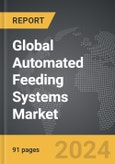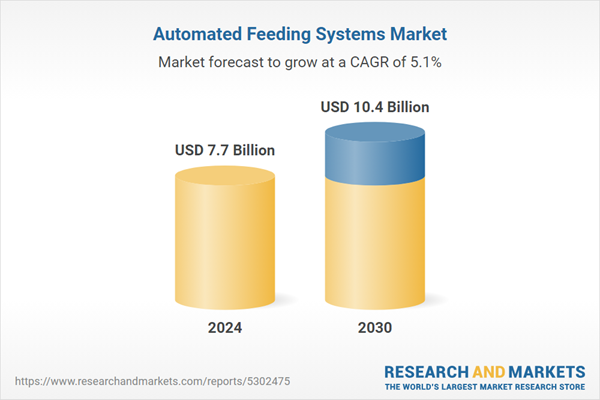Global Automated Feeding Systems Market - Key Trends and Drivers Summarized
What Are Automated Feeding Systems and How Do They Work?
Automated Feeding Systems (AFS) represent a revolutionary advancement in the livestock industry, offering a technology-driven solution to streamline and optimize the feeding process. These systems are designed to automatically dispense food to animals in precise quantities and at scheduled intervals, ensuring that livestock receive the exact nutrients they need for optimal growth and health. The system can be customized according to the specific dietary requirements of different animal groups, from dairy cows and poultry to pigs and sheep. Automated feeders often integrate with sensors that monitor the weight, growth, and health of the animals, using this data to adjust feeding schedules and portions in real-time. Advanced AFS platforms can even be controlled remotely, giving farmers and livestock managers the ability to monitor and modify feeding protocols from any location. By automating what is traditionally a labor-intensive and error-prone task, AFS reduces the risk of underfeeding or overfeeding, leading to healthier animals and more consistent production outputs, while also significantly lowering the workload for farmers and allowing them to focus on other critical aspects of farm management.What Technological Innovations Are Powering the Rise of Automated Feeding Systems?
The rise of Automated Feeding Systems has been fueled by advancements in robotics, Internet of Things (IoT) technologies, and artificial intelligence (AI), all of which work together to create a more efficient, reliable, and adaptable feeding process. Robotics plays a crucial role in AFS, enabling machines to deliver feed accurately, sometimes even to individual animals or specific groups with precision, eliminating waste. IoT integration, on the other hand, allows these systems to connect with other smart devices on the farm, including sensors that track environmental conditions like temperature and humidity, or wearable devices that monitor animal health metrics. This interconnectedness enables a more comprehensive view of the livestock's well-being and can trigger adjustments in feeding if, for example, the system detects that animals are consuming more food during colder weather. AI and machine learning algorithms further enhance AFS by analyzing collected data to predict and adapt feeding requirements over time. These algorithms can process historical feeding data, animal growth patterns, and seasonal changes to optimize feeding protocols, creating a highly adaptive and intelligent feeding ecosystem. Such technological integration has allowed AFS to evolve from simple mechanical feeders to advanced, data-driven solutions that enhance both animal welfare and farm productivity.Where Are Automated Feeding Systems Making the Biggest Impact?
The impact of Automated Feeding Systems is being felt across a variety of livestock sectors, especially in dairy, poultry, and swine farming, where precise nutrition is critical for animal health, product quality, and economic efficiency. In dairy farming, AFS technology helps farmers manage the feeding of high-yielding cows with tailored diets that improve milk production and ensure cows receive consistent nutrition. This level of precision is critical in dairy farming, as nutritional deficiencies or inconsistencies can directly impact milk yield and quality. Poultry farms benefit from automated feeders by reducing labor and minimizing feed waste, which is especially valuable in large-scale operations with thousands of birds where feeding logistics are challenging. For the swine industry, where feed accounts for a substantial portion of production costs, automated feeding systems help optimize growth rates and reduce waste by delivering accurate feed portions based on each animal's growth stage. Beyond these mainstream livestock sectors, even aquaculture has adopted AFS technology, as precise feeding is essential in fish farming to reduce pollution in aquatic environments and improve feed conversion ratios. As agriculture and livestock operations scale up to meet global food demands, AFS has proven to be a valuable investment, contributing to better resource efficiency, higher productivity, and improved animal welfare across diverse farming environments.What's Driving the Growth of the Automated Feeding Systems Market?
The growth in the Automated Feeding Systems market is driven by several factors related to technological advancements, evolving agricultural practices, and changing consumer expectations around food production. The demand for automation in agriculture is one of the key drivers, as farms face increased pressure to scale production and operate efficiently amid labor shortages. Automated feeding systems allow farms to significantly reduce manual labor requirements, which is particularly beneficial as agricultural labor becomes more scarce and costly. Another critical factor is the shift toward sustainable farming practices; as consumers and regulatory bodies alike push for sustainable animal agriculture, AFS technology provides a way to reduce food waste, optimize resource use, and lower the environmental footprint of livestock operations. Additionally, rising awareness of animal welfare has made precision feeding systems more attractive, as they help ensure that animals receive balanced nutrition, reducing stress and improving overall health. Technological advancements in IoT and AI have also made AFS systems more accessible and cost-effective, allowing even smaller farms to adopt this technology and compete with larger operations. Finally, as demand for high-quality animal products grows worldwide, particularly in emerging markets, AFS provides a scalable solution for maintaining product quality and safety. Collectively, these factors underscore the rapid growth and adoption of AFS, positioning it as a transformative technology in modern agriculture.Report Scope
The report analyzes the Automated Feeding Systems market, presented in terms of market value (US$ Thousand). The analysis covers the key segments and geographic regions outlined below.- Segments: Function (Filling & Screening, Controlling, Mixing, Other Functions); Livestock (Ruminants, Swine, Poultry, Other Livestocks); Type (Rail-Guided Feeding Systems, Conveyor Feeding Systems, Self-Propelled Feeding Systems).
- Geographic Regions/Countries:World; United States; Canada; Japan; China; Europe (France; Germany; Italy; United Kingdom; and Rest of Europe); Asia-Pacific; Rest of World.
Key Insights:
- Market Growth: Understand the significant growth trajectory of the Filling & Screening Function segment, which is expected to reach US$4.8 Billion by 2030 with a CAGR of a 5.8%. The Controlling Function segment is also set to grow at 5.3% CAGR over the analysis period.
- Regional Analysis: Gain insights into the U.S. market, valued at $2.1 Billion in 2024, and China, forecasted to grow at an impressive 4.8% CAGR to reach $1.6 Billion by 2030. Discover growth trends in other key regions, including Japan, Canada, Germany, and the Asia-Pacific.
Why You Should Buy This Report:
- Detailed Market Analysis: Access a thorough analysis of the Global Automated Feeding Systems Market, covering all major geographic regions and market segments.
- Competitive Insights: Get an overview of the competitive landscape, including the market presence of major players across different geographies.
- Future Trends and Drivers: Understand the key trends and drivers shaping the future of the Global Automated Feeding Systems Market.
- Actionable Insights: Benefit from actionable insights that can help you identify new revenue opportunities and make strategic business decisions.
Key Questions Answered:
- How is the Global Automated Feeding Systems Market expected to evolve by 2030?
- What are the main drivers and restraints affecting the market?
- Which market segments will grow the most over the forecast period?
- How will market shares for different regions and segments change by 2030?
- Who are the leading players in the market, and what are their prospects?
Report Features:
- Comprehensive Market Data: Independent analysis of annual sales and market forecasts in US$ Million from 2024 to 2030.
- In-Depth Regional Analysis: Detailed insights into key markets, including the U.S., China, Japan, Canada, Europe, Asia-Pacific, Latin America, Middle East, and Africa.
- Company Profiles: Coverage of players such as Afimilk, Boumatic LLC, Dairy Master, Davisway, Delaval and more.
- Complimentary Updates: Receive free report updates for one year to keep you informed of the latest market developments.
Some of the 38 companies featured in this Automated Feeding Systems market report include:
- Afimilk
- Boumatic LLC
- Dairy Master
- Davisway
- Delaval
- Fullwood Packo
- GEA
- Lely Holding
- Pellon Group Oy
- Sum-It Computer Systems
This edition integrates the latest global trade and economic shifts into comprehensive market analysis. Key updates include:
- Tariff and Trade Impact: Insights into global tariff negotiations across 180+ countries, with analysis of supply chain turbulence, sourcing disruptions, and geographic realignment. Special focus on 2025 as a pivotal year for trade tensions, including updated perspectives on the Trump-era tariffs.
- Adjusted Forecasts and Analytics: Revised global and regional market forecasts through 2030, incorporating tariff effects, economic uncertainty, and structural changes in globalization. Includes historical analysis from 2015 to 2023.
- Strategic Market Dynamics: Evaluation of revised market prospects, regional outlooks, and key economic indicators such as population and urbanization trends.
- Innovation & Technology Trends: Latest developments in product and process innovation, emerging technologies, and key industry drivers shaping the competitive landscape.
- Competitive Intelligence: Updated global market share estimates for 2025, competitive positioning of major players (Strong/Active/Niche/Trivial), and refined focus on leading global brands and core players.
- Expert Insight & Commentary: Strategic analysis from economists, trade experts, and domain specialists to contextualize market shifts and identify emerging opportunities.
Table of Contents
Companies Mentioned (Partial List)
A selection of companies mentioned in this report includes, but is not limited to:
- Afimilk
- Boumatic LLC
- Dairy Master
- Davisway
- Delaval
- Fullwood Packo
- GEA
- Lely Holding
- Pellon Group Oy
- Sum-It Computer Systems
Table Information
| Report Attribute | Details |
|---|---|
| No. of Pages | 227 |
| Published | December 2025 |
| Forecast Period | 2024 - 2030 |
| Estimated Market Value ( USD | $ 7.7 Billion |
| Forecasted Market Value ( USD | $ 10.4 Billion |
| Compound Annual Growth Rate | 5.1% |
| Regions Covered | Global |









